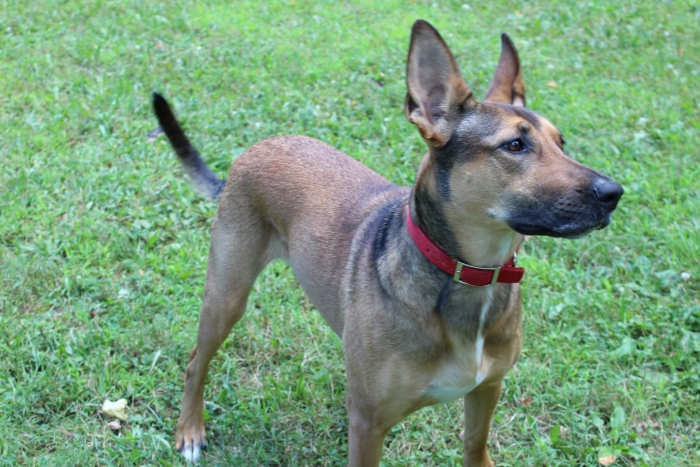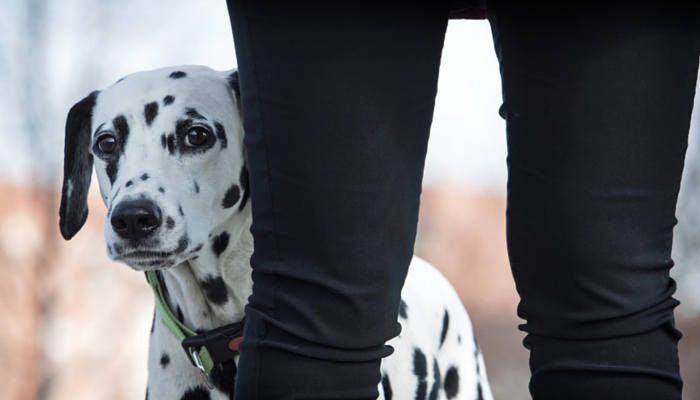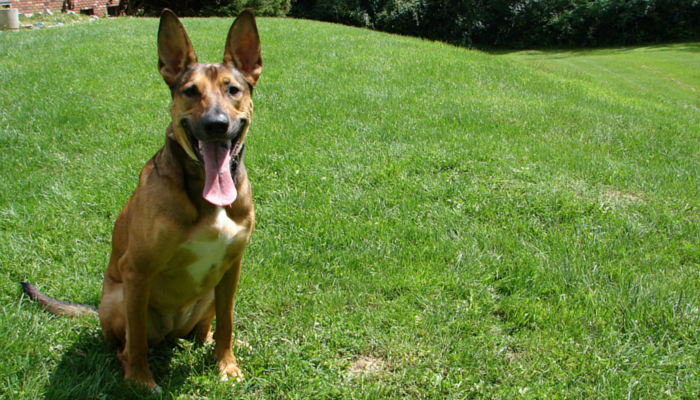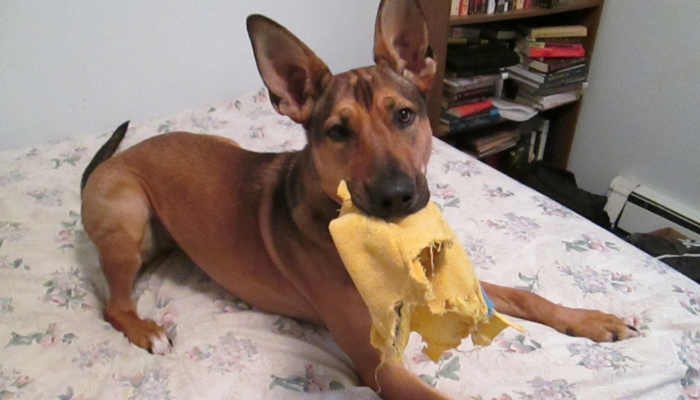5 Ways to Boost Your Dogs Confidence
Does your dog act shy or fearful around new people or situations? If so you’re not alone. A lot of dogs have confidence issues, even when we try our best to socialize them well. Luckily there are a few things you can do to boost your dogs confidence.
My favorite method for boosting a dog’s confidence is to use some basic obedience skills. Basics like sit, stay & down are great for this. As simple as it seems these commands can help take your dogs mind off of scary situations and put that focus back onto you, and over time they’ll start to feel safer in those unknown situations.
If you want to help your dog conquer their fears around new people and situations look no further, here’s 5 ways to help boost your dog’s confidence.
Building Up Your Dogs Confidence Will Take Time
There’s no quick fix for helping a shy or fearful dog build up his confidence – it’s going to take time and patience on your part. But once you start working on obedience and positive reinforcement training you will start to notice a difference in your dogs focus. Rather than fixating on all the scary things they’ll start to look to you for their next cue.
And one thing to keep in mind is that it’s a process, it’s not a quick overnight fix. Learning how to shift your dogs focus from being scared of certain things or situations and turning it into something positive takes time. So remember to be patient, and don’t be too hard on yourself (or your dog) if you don’t see dramatic results overnight; overcoming fearfulness and anxiety doesn’t happen overnight.
How Training Will Boost Your Dogs Confidence
When faced with something scary our dogs have a tendency to focus on that scary thing and ignore everything else. I’m the same way. If a big scary scorpion lands on my desk I’m getting up. I’m not going to finish watching that funny cat video, not until that thing is gone.
Our dogs do the same thing. The scary thing becomes their focus, and until you can shift their attention that big scary thing is going to be the only thing they’re focused on. It’s our job to help show them that the scary thing isn’t so scary after all, and one of the best ways to do that is by redirecting their attention.
The more skills your dog learns, the more positive things your dog will have to focus on distracting her from dwelling on the things she previously feared. Start by teaching “Sit”, “Stay” and “Down” very useful commands that will also help the dog gain a sense of accomplishment and have something to do to earn your praise. – Help for the Shy & Fearful Dog, Paw Rescue
When you give your dog something to focus on rather than the scary thing (in this case some basic obedience work), it gives them something else to concentrate on, rather than just being afraid. And the more they see that nothing bad happens around that scary thing, the more confident they’ll be around it.
Desensitization to scary things take time, and success won’t happen overnight. Fear is an emotional response, and that can be challenging to overcome.
If you’re afraid of heights you know that all the yummy treats in the world isn’t enough to alleviate that fear. It takes time and gradual exposure, and in the best case scenario a good friend to help shift your focus away from ‘OMG heights’ onto something else. You can be that person for your dog. Take their attention away from all the scary things, and shift it onto something positive like training.
It takes time, but you can increase your dog’s confidence through training. It’s teaching your dog new skills, and those skills help shift their focus onto something positive.
How I Taught My Dog to be Brave Around Strangers
Laika was fearful of new people when we got her. She’d cower & grovel every time she was approached by someone new. To get her focus around new people I used the “look at me” cue and lots of yummy treats. Socialization with a fearful dog will take a lot of time and patience, but it does get better.
Since it was people that she was afraid of I did have the advantage of being able to tell people to approach her slowly – you might not have that option if your dog is fearful of other dogs. If your dog is fearful around new dogs I suggest taking it slowly when approaching, and don’t be afraid to walk away if you don’t think that initial meeting will go well. It’s much better to leave on a neutral note with your dog than have a bad experience.
Helping a shy or fearful dog will take patience & dedication, and it’s something you’ll need to continually work on when your dog becomes nervous in a new situation. But teaching your dog a few basic commands that they can focus on when dealing with new situations will be a great help. Here’s the five steps I used to build up my dogs confidence.
1. Start With Basic Obedience On Walks
Never knowing when we’d be running into someone that would trigger my dog’s fear I decided prepare myself every time we left the house. I’d take a bunch of yummy treats (chicken or hot dogs) along to make sure I had something that would be able to keep her attention if need be. If your dog’s not that into treats you can try using a game of tug to keep their attention.
Whenever I noticed someone off in the distance approaching we’d stop walking and start working on our cues. My favorite is the “look at me” cue followed by a simple sit & stay.
After doing this a few times I noticed that I was able to hold Laika’s attention for longer periods of time before she even noticed a new person coming towards us. Her focus was staying on me (and those awesome chicken treats) and away from the scary person.
Treats and positive reinforcement will help your dog realize that people coming towards them isn’t such a bad or scary thing after all since they know you’re right by their side and will keep them safe. Showing your dog that those scary things aren’t so scary after all is called counter conditioning, and it’s a well established way to help boost a shy dog’s confidence around new things.
The one thing you need to pay attention to is your dog’s body language. For the best results you want to start giving your dogs treats and praise as soon as they notice someone in the distance from a safe distance.
If you wait too long your dog may be too riled up already, and getting their attention while they’re barking or lunging is pretty much impossible. If that happens it’s OK; accidents happen. Safely remove yourself from the situation and try again tomorrow.

After working with your dog you’ll be able to spot the moment they start to lose focus. To reduce those moments you might need to slow down the pace. If your dog is fearful of strangers you’ll need to take it slow, success won’t happen overnight.
2. Move Onto New & Scary Situations
After she was comfortable with people approaching us on walks we moved onto the pet store & vets office. That was a whole new beast. Lots of interesting sights, sounds & smells – and a lot of new people she needed to get comfortable around.
The first few trips we took to the pet store were pretty disastrous. If you’ve ever tried getting your dog’s attention in the middle of a pet store with 15 other dogs, 25 people & multiple cats running around you know what I’m talking about.
It was too much too soon. And when you’re working with a fearful dog you’re going to have days where you get discouraged – but don’t give up. You can always start again, and the more you practice the more familiar you’ll get with your own dogs fear threshold.
Since the first few trips to the pet store had gone so badly I decided to only go during off hours when there were far less people coming in and out. We’d work on “look at me” down one aisle for awhile and then move onto the next one.
When we took our time (and when it wasn’t full of 25 people & their dogs) it went much smoother.
We’d also take trips to the vets office to get her used to being in that often over stimulating environment. We’d walk in and I’d have her sit on the scale to be weighed and she’d get praised like crazy. The staff got to know us and after awhile Laika wasn’t bothered at all when we went there.
Before moving onto scary situations we worked on our “look at me” cue at home in a more laid back, non stressful environment.
3. Start Far Away from Scary Things
When facing something new or scary dogs have a certain stress threshold. You’ll notice that the closer you get to the scary object the more uneasy your dog becomes. When working with a fearful dog it’s important to remember not to cross that threshold too fast. Let your dog get used to that new scary person or dog in the distance, and then slowly make your way towards it.
When you get too close to the stimuli it’s hard, if not impossible, to divert your dogs attention. Many dogs won’t even take a treat when they’re that close to something scary. When you go out to work on some obedience training you’re going to want to start far enough away from the scary situation that your dog is still able to focus onto you.
If you notice that you’ve gotten too close to the scary situation and are unable to get his focus you’ll need to move back. After a few tries you’ll start to see where your dogs fear threshold is and you’ll be able to find an area that works for your dog.
4. Your Dog Will Start to Associate Training With Good Things
Whether you’re brushing up on old skills like “sit” or teaching new commands like “look at me” you’re going to want to use lots of praise and treats. Keep these little obedience lessons fun for your dog. The more you praise them & keep it fun the more likely they’ll be to pay attention to you when you ask them to do it when faced with a new situation.
Don’t punish your dog if they don’t perform the action right away. Chances are you’re either too close to the scary situation or you’re not clearly communicating what it is you want from them. If you punish a fearful dog you risk reinforcing that fear and making it worse.
If you keep the training positive your dog will begin to associate obedience work with praise & treats, and that will make facing scary situations easier on them.
5. Keep Working Your Way Through New Situations
To further boost your dog’s confidence you can keep moving onto new places & scary situations with the tips mentioned above. That’s what’s so great about something basic like obedience work – it’s simple and can be done nearly anywhere.
If your dog is comfortable around those kids that ride their bikes in your neighborhood move onto a trip to the park where there’s going to be even more bikes.
A Few Extra Confidence Building Exercises
While we already covered how to boost your dog’s confidence in the outside world, there are a few things you can do at home to help such as using food puzzles and nose work games. Teaching your dog some new tricks can also be a great little confidence boost to you and your dog alike.
Those sorts of mentally stimulating activities will keep your dog busy and give them a positive way to burn off some energy, all while learning the world is a fun place with interactive things they can enjoy on their own.
You Can Boost Your Dogs Confidence
Whether your dog’s afraid of hats, holiday decorations or spiders you can boost their confidence. Desensitization helps your dog focus on something other than fear, and in time it turns those negative emotions into positive ones.
As long as you keep training below threshold & while you have your dog’s attention you keep can moving forward. You can be that good friend to your dog, the one that shows you that heights aren’t so bad after all. You can help boost you dogs confidence by giving him direction. Show him what do to when faced with new & scary situations.
Recommended Reading
Here’s some more tips on how you can build up your dogs confidence in various situations:





I haven’t had to deal with this yet, but I will keep your tips in mind, just in case.
Great article!! We’ve done most of this to help out fearful girl.
We are dealing this with Bruin, our youngest golden. He is fearful at times of people, so glad to read this. Will definitely look into your recommended reading. Thanks for sharing!
Great article and great advice but it was your dog’s photos that made my heart skipp a beat. Tosca ( who looks identical to your dog) was a rescue and turned out to be GSDx Staffi. What is your beautiful dog in the picture?
She’s a German Shepherd/Staffi mix as well. We did a Wisdom Panel test a few years back and they found some Rottweiler and Bernese Mountain Dog mixed in as well. Here’s the results if you’re interested: https://www.puppyleaks.com/laikas-dna-test-results/
Thank you so much. Don’t know how to attach a photo of her but actually don’t have to. You have my dog’s pictures:)
What do you do when your dog is not play or treat motivated? I have a German Shepherd who was previously abused. She is fearful. She barely cares about treats. She won’t play with toys. We have made great strides but she still barks when my 8yo nephew (or other boys around his age) comes within 10 feet of her. Sometimes she lets my niece pet her. It has been 3 years and I try to work with her slowly but it scares the kids when she barks and they don’t listen when I say don’t come closer. Then my mom and sister snipe at me about my ill-behaved dog and how they will “punch her in the head” if she bites them (she has NEVER been aggressive or used her teeth in fear). How can I work on her confidence and fear if they aren’t calm enough, listen well enough, or brave enough to work with me and treats and toys don’t appeal to her?
I’d keep her away from your family members since they obviously don’t understand the trauma she’s suffered in the past. What makes her happy? She’s not play or treat motivated but is there anything else that makes her perk up? I wish you all the best with your sweet pup. Thank you for giving her a loving home and a family. <3
My dog is about a year and a half old and barks so loudly when someone comes to the door and barks so loud I can’t hear when I open the door, how can you stop that?! It’s so annoying!! She barks at the grandkids until they pay attention to her and play ball with her but just barks at neighbors outside for no reason.
hello, so curious is to know the breed of this dog in your article? Is this Laika you are referring to in your article? Thank you so much for the good read and I am looking forward to reply to let me know what is anything she is mixed with or what her breed is.